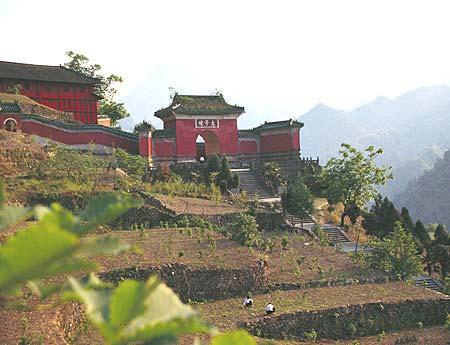
 |
| It is said that Zhenwu lived at the Fuzhen Temple (Taizipo) when he practiced his religion. (CNTV) |
The Wudang Mountains, also known as Taihe Mountain or Xuanyue Mountain, is located to the southwest of Danjiangkou, Hubei Province and is a famous Taoist holy land in China. According to legend, the Emperor Zhenwu, who was worshiped by Taoists, was immortalized there. Wudang means that no one can undertake this post except Zhenwu. The Wudang Mountains have many natural and manmade landscapes. The natural landscapes, including three ponds, nine brooklets, nine wells, nine platforms, 10 pools, 10 stones, 11 caves, 24 caves, 36 cliffs and 72 peaks, are beautiful and splendid.
The Tang, Song, Yuan, Ming and Qing dynasties all left buildings in the Wudang Mountains and the Ancient Building Complex in the Wudang Mountains was founded during the reign of Emperor T'ai-tsung (627-649) of the Tang Dynasty. T'ai-tsung Li Shimin ordered his people to construct the Wulong Ancestral Hall. In the Song Dynasty, the Wudang Taoism that worshiped the Emperor Zhenwu and directly served the royal family was basically formed. However, in the late Yuan Dynasty, most of the ancient buildings in the Wudang Mountains had been destroyed by wars. The Ming Dynasty was the most vigorous period for the development of the Wudang Mountains. Emperor Zhu Di gave the Wudang Mountains the title of “Dayue,” and Emperor Zhu Houcong called it the “Zhishi Xuanyue,” which was the most honored among all Five Mountains. During this period, a large number of buildings were constructed in the Wudang Mountains.
According to the historical records, Emperor Zhu Di believed in Taoism and ordered 300,000 people to enter the Wudang Mountains in 1412 (the 10th year of the Yongle Period during the reign of Emperor Zhu Di in the Ming Dynasty) after the construction of the Forbidden City, the Imperial Ancestral Temple, Altar of Land and Grain, and Temple of Heaven in Beijing were finished. They built many buildings and over a 13-year span, they constructed relevant and complete architectural complexes from the Jingyue Palace in the Yun County (today’s Danjiangkou) to the Jinding of Tianzhu Peak stretching 70 kilometers, which included nine Taoist temples, nine palaces, 12 kiosks, 36 nunneries, 39 bridges and 72 temples. There are more than 20,000 palaces and 400 temples that cover an area of 1.6 million square meters. In 1552 (the 31st year of the Jiajing Period in the Ming Dynasty), the memorial archway “Zhishi Xuanyue” was constructed and the architectural complex in the Wudang Mountains was basically formed.
 |  |
















 Rainstorms flood more than 10,000 cars in underground garages in Wuhan
Rainstorms flood more than 10,000 cars in underground garages in Wuhan


![]()
